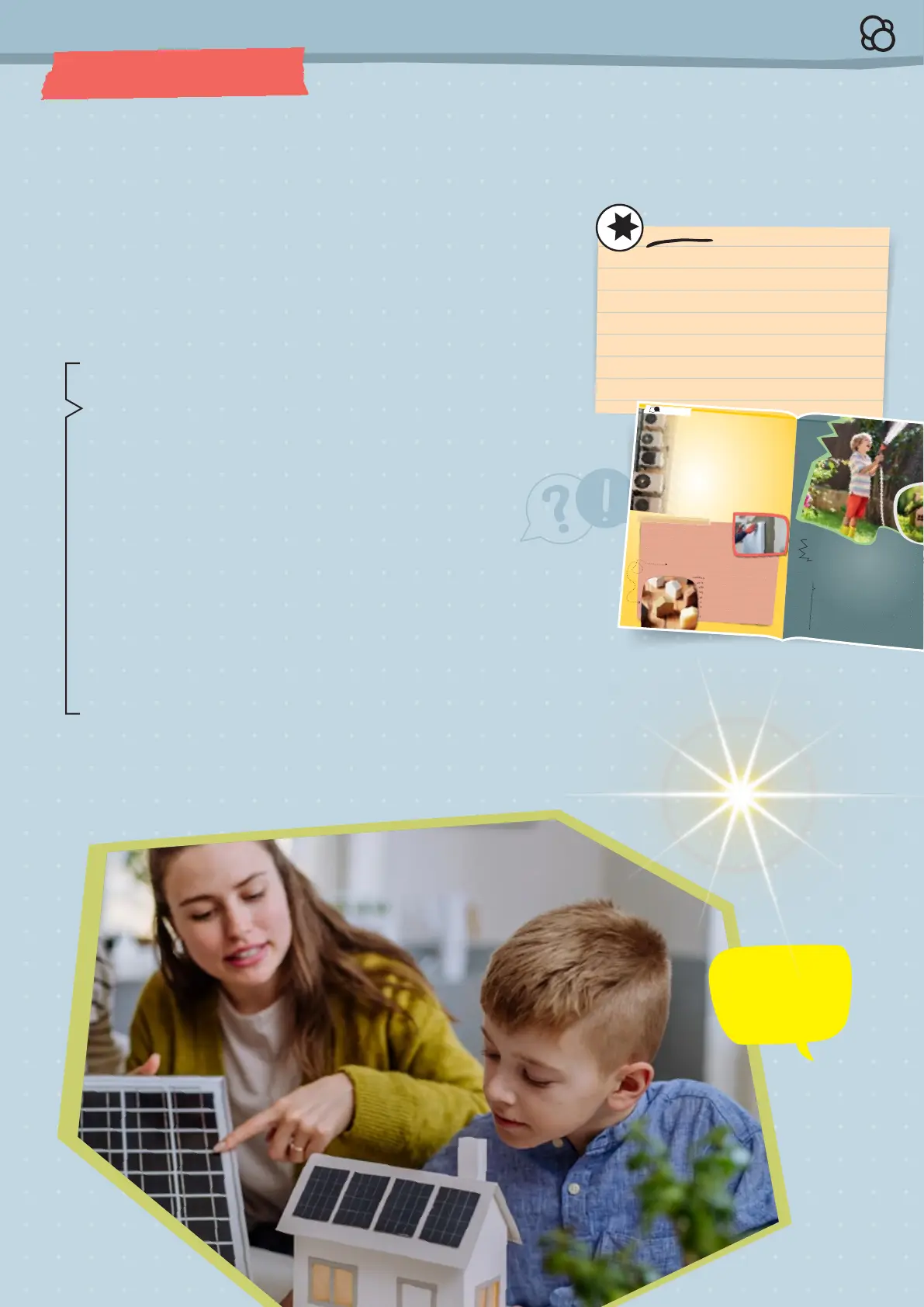Thames & Kosmos Green Engineering: Clean Energy & Sustainable Living handleiding
Handleiding
Je bekijkt pagina 3 van 36

— Natürliche heiße Quellen auf Island
—
Setzt man ein Gas unter Druck (komprimiert es), verflüssigt es sich und erwärmt sich
dabei. Nimmt man den Druck weg, verdampft es wieder und entzieht dabei seiner
Umgebung Wärmeenergie. Dieses Prinzip nutzt die Wärmepumpe. In ihr kreist solch ein
Kältemittel und wird abwechselnd komprimiert und entspannt. In Rohrschlangen im
Freien nimmt es Wärme auf, etwa aus der Luft oder dem Grundwasser.
In Heizkörpern im Haus gibt es sie wieder ab, mit etwas höherer Temperatur.
Zwar verbraucht eine Wärmepumpe Strom für die Kompression, insgesamt aber liefert
sie mehr Wärme als etwa eine elektrische Heizung bei gleichem Stromverbrauch.
Damit sie gut funktionieren, sollte das Haus gut gedämmt sein.
— GEOTHER MIE nennt man d ie Nutzung von
Erdwärme. Einfache Hausan lagen gewinnen per
Wärmepumpe die Wärmeenerg ie im Grundwasser.
Größere Anlagen zapfen die Hit ze von
Tiefengesteinen an. Das funk tioniert besonders gut in v ulkanisch
aktiven Gebieten, etwa Island oder Neuseeland.
Bei der SOLARTHERMIE wird Sonnenwärme
mittels großer dunkler Solarkollektoren aufgefa ngen,
die flüssigkeitsgefüllte Rohrsch langen enthalten.
Sie leiten die Wärme ins Haus, wo sie zum Heizen
oder zur Warmwasserbereitung genutzt w ird.
Nachhaltig
heizen
— Solarkollektoren über einer Photovoltaik-
Anlage mit Solarzellen
25
— Nachgehakt
25
Was ist eigentlich
eine Wärmepumpe?
?
!
NACHGEHAKT
Insulati
Insulating a building prevents heat loss through the facade to
the outside, especially in regions where it gets cold in winter. In
addition, it prevents interior rooms from heating up as much on
sunny summer days. However, the insulation materials used are
usually porous plastics such as polystyrene (also known as Styrofoam), which are flammable and
non-renewable. There are also non-flammable mineral-based insulation materials, as well as
those made from renewable materials such as wood, hemp or plant fibers. All of these materials
contain small air-filled spaces (similar to a sweater). Since
air is a poor conductor of heat, they have an insulating
effect. The insulation materials are usually pressed into
solid panels, attached to the outside walls and then
plastered over or sandwiched between interior and
exterior walls. There are also bricks whose hollow
spaces are filled with insulation. Installing insulation
materials in a house costs money, but they soon pay
for themselves through the energy costs saved.
Air Conditioners
–
do they
make
sense
?
Temperatures that are too hig h in summer are exh austing: they disrupt sleep
and make you tired and unable to concentrate. Not to mention that extreme
heat can be dangerous, especial ly for older people. An air conditioning system
can help there. It cools and dehumidifies the a ir and thus improves the
indoor climate. However, air conditioning systems use a lot of electricity. It’s
therefore best to combine them with photovoltaics — which provide a lot of
energy, especially on hot days. Incidentally, there are ty pes of heat pumps
that can also cool — instead of tran sporting heat from the outside to the
inside, they work the other way around.
2524
?
CHECK IT OUT
You may have seen building s with a green roof or facade covered in
plants. In thi s chapter, you’ll find out why this ca n be sustainable and
counteract global warm ing. Building and living consu me other things
besides energy: water, for example, but also space and surfaces in a
city. Can green roofs help counteract the consequences of this la nd
consumption? Find out! Of course, you’ll first have to put a grass roof
on your own model house!
Greening
&
Insulati
Insulating a building prevents heat loss through the facade to
the outside, especially in regions where it gets cold in winter. In
addition, it prevents interior rooms from heating up as much on
sunny summer days. However, the insulation materials used are
usually porous plastics such as polystyrene (also known as Styrofoam), which are flammable and
non-renewable. There are also non-flammable mineral-based insulation materials, as well as
those made from renewable materials such as wood, hemp or plant fibers. All of these materials
contain small air-filled spaces (similar to a sweater). Since
air is a poor conductor of heat, they have an insulating
effect. The insulation materials are usually pressed into
solid panels, attached to the outside walls and then
plastered over or sandwiched between interior and
exterior walls. There are also bricks whose hollow
spaces are filled with insulation. Installing insulation
materials in a house costs money, but they soon pay
for themselves through the energy costs saved.
Air Conditioners
–
do they
make
sense
?
Temperatures that are too hig h in summer are exh austing: they disrupt sleep
and make you tired and unable to concentrate. Not to mention that extreme
heat can be dangerous, especial ly for older people. An air conditioning system
can help there. It cools and dehumidifies the a ir and thus improves the
indoor climate. However, air conditioning systems use a lot of electricity. It’s
therefore best to combine them with photovoltaics — which provide a lot of
energy, especially on hot days. Incidentally, there are ty pes of heat pumps
that can also cool — instead of tran sporting heat from the outside to the
inside, they work the other way around.
2524
?
CHECK IT OUT
You may have seen building s with a green roof or facade covered in
plants. In thi s chapter, you’ll find out why this ca n be sustainable and
counteract global warm ing. Building and living consu me other things
besides energy: water, for example, but also space and surfaces in a
city. Can green roofs help counteract the consequences of this la nd
consumption? Find out! Of course, you’ll first have to put a grass roof
on your own model house!
Greening
&
TABLE OF CONTENTS
1
Green Engineering
T
AItNa inRmIo
c b FoD t
CCk T T
CtNs
o PaS
11
, 1,
1
7
, 2
3
,
2
4
, 2, N 3
Kit Contents ..................................... Inside front cover
Table of Contents ........................................................ 1
Important Information ................................................ 2
Your Model House ........................................... 5
Assemble, install technology, and decorate!
EXPERIMENTS START ON PAGE 13
Energy for Your House ................................... 12
Get to know the source of energy for your home, then
store and use the energy!
Heating & Cooling .......................................... 18
Heating and cooling your home in dierent ways
Climate Adaptation & Greening ...................... 25
Green the roof and learn how cities can adapt
to a changing climate
Your House’s Second Life ................................ 29
Upcycling ideas for the parts of your house
when you’re done experimenting
Ready?
— let’s go !
6279 31- 0 2-210125
Bekijk gratis de handleiding van Thames & Kosmos Green Engineering: Clean Energy & Sustainable Living, stel vragen en lees de antwoorden op veelvoorkomende problemen, of gebruik onze assistent om sneller informatie in de handleiding te vinden of uitleg te krijgen over specifieke functies.
Productinformatie
| Merk | Thames & Kosmos |
| Model | Green Engineering: Clean Energy & Sustainable Living |
| Categorie | Niet gecategoriseerd |
| Taal | Nederlands |
| Grootte | 33452 MB |







